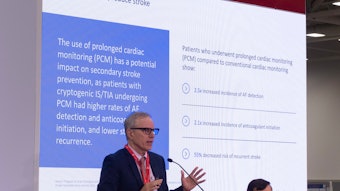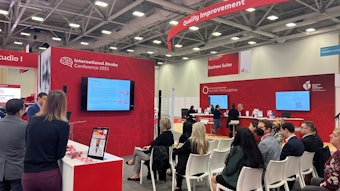Late-breaking trials explore issues related to BP care, statin, recovery and more

Thursday’s Main Event highlighted trials that offer new insights into ischemic stroke recovery, managing blood pressure after ischemic stroke and thrombectomy and after intracerebral hemorrhage, and cerebral cavernous malformation rebleeding. Researchers reported:
- Transcranial direct current stimulation did not amplify the treatment effect from intensive rehabilitation therapy in patients with their first ischemic stroke and persistent arm weakness.
- Intensive blood pressure management did not improve outcomes in patients with ischemic stroke after thrombectomy.
- Stroke care coordination protocol improved post-stroke blood pressure and cholesterol but not daily function or quality-of-life outcomes.
- Intensive systolic blood pressure lowering is not associated with diffusion-weighted imaging lesions in patients with intracerebral hemorrhage.
- A widely used statin did not reduce cerebral cavernous malformation biomarkers of bleeding risk.
Adding transcranial direct current stimulation to modified constraint-induced movement therapy did not enhance motor recovery in patients with stroke Transcranial direct current stimulation (tDCS) is a noninvasive brain stimulation device powered by a 9-volt battery. Research has shown it can modulate motor cortical excitability, modify stroke-induced interhemispheric imbalance and increase synaptic plasticity when paired with rehabilitation therapy. But tDCS did not amplify the treatment effect from modified constraint-induced movement therapy (CIMT) in patients with first-ever ischemic stroke with persistent arm weakness, according to findings from TRANScranial Direct Current Stimulation for Post-Stroke Motor Recovery: A Phase 2 Study (TRANSPORT2).
The trial was conducted at 15 U.S. StrokeNet enrollment sites from 2019 to 2024. It randomly assigned 129 participants 1:1:1 to sham stimulation, low-dose transcranial direct current stimulation (2 milliamperes) or high-dose transcranial direct current stimulation (4 milliamperes), combined with modified CIMT. All patients were one to six months from the stroke onset. Feng
Feng
The concept of constraint-inducement movement therapy is to overcome the learned nonuse of the affected hand by immobilizing patients’ nonaffected hand with a glove or mitten, forcing them to use the affected hand, said principal investigator Wayne Feng, MD, MS, chief of the Division of Stroke & Vascular Neurology and professor of neurology and biomedical engineering at Duke University School of Medicine.
“It has been proven to be effective for certain stroke patients with preserved distal hand movement. Transcranial direct current stimulation stimulated the affected side of the brain while inhibiting the unaffected side of the brain,” Feng said.
The new study’s primary aim was to measure the treatment effect in the three groups on day 15, plus or minus two days, immediately after a 10-session intervention period. All groups received the same adjunctive rehabilitation therapy, which included two hours of active therapy time. The first 30 minutes of each session consisted of simultaneously applying transcranial direct current stimulation, with modified CIMT for all three groups. The primary endpoint was the mean change in arm motor impairment as measured on the c (FM-UE) scale between baseline and day 15±2. FM-UE scores about one month after the intervention (day 45±5) and three months after (day 105±10) were also collected to assess the sustained benefits.
“Patients with first ischemic stroke with persistent arm weakness but with some degree of distal hand movement can benefit from 10 sessions of two hours of constraint-inducement movement therapy over two weeks. But adding transcranial direct current stimulation up to 4 milliamperes does not appear to induce further improvement, although it is safe and tolerable,” Feng said. “All three groups improved at day 15 but the effect did not separate.” Improvement was sustained to day 45 and day 105, but again, the groups’ improvement was similar.
Feng noted that after TRANSPORT2 started, more data became available suggesting currents higher than 4 milliamperes can be safely and tolerably applied with potentially better effects in modulating brain activities. Future studies may be considered using higher doses of tDCS or a personalized dosing approach, Feng said. The study will be published in Lancet Neurology.
Intensive blood pressure management did not show benefit after thrombectomy
Intensive blood pressure management did not improve outcomes in patients with acute anterior circulation ischemic stroke who had endovascular thrombectomy within six hours from onset and had successful recanalization, results from a randomized clinical trial called IDENTIFY show. IDENTIFY, an open-label, blinded-endpoint trial, studied 383 patients with ischemic stroke due to large vessel occlusion in anterior circulation. The patients were randomized to intensive management, with a systolic blood pressure target of lower than 130 mmHg (183 patients), or to standard management, with a systolic blood pressure target of lower than180 mmHg (200 patients). The trial was conducted at 63 stroke centers in China between October 2022 and March 2024. Patients had a mean age of 72, and nearly half were women. Median baseline NIH Stroke Scale Score was 15.
Of enrolled patients, 162 (42.2%) received intravenous thrombolysis, and 202 patients (52.7%) had endovascular thrombectomy under general anesthesia. Blood pressure reduction was initiated within one hour and maintained for 24 hours after randomization.
In the intensive management group, 24-hour mean systolic blood pressure was significantly lower, compared with the standard management group. The primary outcome was patients’ functional levels as assessed by modified Rankin Scale (mRS) score at 90 days after thrombectomy. Secondary outcomes included intracerebral hemorrhage occurrence, malignant brain edema and early neurological improvement. In the intensive-management group, 71.0% of patients had an unfavorable functional outcome, compared with 67.5% of patients in the standard management group. There was also no significant difference between groups in the risks of secondary outcomes. Hypotension within 24 hours after thrombectomy occurred more frequently in the intensive management group (relative risk 1.76). There was no significant difference between treatment groups in adverse events during hospitalization.
“Our findings did not support intensive blood pressure management after successful thrombectomy regardless of the duration of the ischemic period,” said principal investigator Bo WuXuening (Linty) Zhang, MD, a doctoral student at Sichuan University/West China Hospital, in Chengdu, China. AHA/ASA stroke guidelines recommend maintaining blood pressure at or below 180/105 mmHg for 24 hours after recanalization.
Stroke care coordination protocol improved post-stroke blood pressure and cholesterol but not daily function or quality-of-life outcomes
Health care facilities with Comprehensive Stroke Care/Primary Stroke Care (CSC/PSC) certifications for acute stroke management and in-patient care have been shown to improve stroke outcomes. But despite proven interventions, these care models do not address patient management for post-discharge rehabilitation and long-term care. So researchers examined whether a care delivery model that encompasses all four stages of stroke care (acute management, in-hospital care, post-discharge rehabilitation and long-term care) could improve patient functional outcomes and quality of life. On Thursday, researchers presented findings addressing that question — from a trial labeled Coordinated, Collaborative, Comprehensive, Family-Based, Integrated, Technology-Enabled Post-Stroke Care (C3FIT).
C3FIT, a cluster trial conducted at 21 U.S. hospitals, randomized 1,196 patients with stroke to usual care according to Joint Commission-certified CSC/PSC design (580 patients) or to a novel Integrated Stroke Practice Unit (ISPU) design for stroke care (616 patients). The ISPU design used team-based, enhanced collaboration and followed patients from presentation at the emergency department through 12 months after discharge. The post-discharge phase, known as Stroke Mobile, included a nurse and lay health education team who visited patients and caregivers at home or at rehabilitation or skilled nursing facilities. The team assessed patients’ function and quality of life using telehealth technology to facilitate access to multiple providers. Both patient groups were followed to assess intermediate outcomes, including blood pressure control, glucose and lipid levels, smoking cessation, diet quality and physical activity patterns.
Primary outcomes were functional outcome assessed by modified Rankin score (mRS) and quality of life assessed by the Stroke Impact Scale (SIS), both at 12 months. ISPU care significantly increased the proportion of patients meeting treatment thresholds for blood pressure and adherence to diet guidelines, results showed. The study also found an increase in the proportion of patients meeting treatment thresholds for low density-lipoproteins, but the difference was attenuated by adjustment for stroke severity. Finally, ISPU showed nonsignificant positive trends for improving exercise patterns. Sufficient data could not be obtained regarding smoking cessation and HbA1c measurements. Howard
Howard
“The positive responses on the intermediate outcomes were not reflected in improved functional or quality of life improvements,” said co-investigator George Howard, DrPH, professor emeritus at the School of Public Health at the University of Alabama at Birmingham.
“We speculate that we did not see improvements because the one-year follow-up was not sufficient to reap the benefits of improving the intermediate measures.” There also could be bias through a substantial frequency of missing data in the trial, he said, and the modified Rankin score and Stroke Impact Scale may not be sensitive enough measures of improved stroke outcomes.”
Howard noted that more patients with more severe strokes were included in the ISPU arm, further complicating interpretation of the findings. Still, “the evidence that ISPU-organized care improved post-stroke risk factors, with greatest impact on blood pressure, diet and LDL-C, should motivate clinicians who share that belief to implement the ISPU approach.The success with improving many of the intermediate outcomes is promising and should strongly motivate continued investigations with longer follow-up or different outcome measures,” he said.
Intensive systolic blood pressure lowering is not associated with diffusion-weighted imaging lesions in patients with intracerebral hemorrhage
Roughly 1 in 4 patients with intracerebral hemorrhage, the deadliest form of stroke, will develop diffusion-weighted imaging lesions separate from the hematoma. These MRI signatures of ischemic injury are associated with poorer functional outcomes. Major clinical trials have shown that rapidly reducing blood pressure may improve clinical outcomes by reducing the likelihood of intracerebral hemorrhage expansion. But other evidence indicates that diffusion-weighted imaging lesions may be related to blood pressure reduction. Butcher
Butcher
On Thursday, final results were presented of a study addressing the contradiction, the Intracerebral Hemorrhage Acutely Decreasing Arterial Pressure Trial II. This multicenter, open-label, blinded-endpoint trial randomized 162 patients with intracerebral hemorrhage to intensive systolic blood pressure treatment with a target of lower than 140 mmHg or a usual care systolic target of lower than 180 mmHg within six hours of onset of the brain bleed. The primary outcome, diffusion-weighted lesion incidence assessed on MRIat 48 hours, occurred in about 1 in 3 patients, with most lesions at low volume.
Overall, results showed no increase between the two groups in the frequency of diffusion-weighted imaging lesions at 48 hours, despite a nearly 13 mmHg difference in achieved systolic blood pressures during that window. Diffusion-weighted imaging lesions were detected in 28.6% of patients in the intensive treatment group and 37.8% of patients in the usual care group (p=0.237). Multivariate logistic regression indicated that ischemic lesions were predicted by baseline intracerebral hemorrhage volume (p=0.002), but not by systolic blood pressure treatment. The median number of diffusion-weighted imaging lesions and total lesion volume did not differ between the two treatment groups.
“Our data provide reassurance that intensive blood pressure lowering is safe and support current American Heart Association/American Stroke Association guidelines that suggest targeting systolic blood pressure to 140 mmHg,” and maintaining it in the range of 130 to 150 mmHg, in patients with acute mild to moderate intracerebral hemorrhage, said lead researcher Ken Butcher, MD, director of clinical neurosciences at the University of New South Wales in Sydney, Australia. “Intensive blood pressure control doesn’t precipitate or aggravate MRI signatures of ischemic injury after intracerebral hemorrhage.” The trial was stopped early after publication of other trials showing that intensive blood pressure reduction was beneficial. In addition, clinical guidelines were updated recently, citing more evidence for an intensive approach. Butcher noted that diffusion-weighted imaging lesions were more common in trial participants with larger intracerebral hemorrhage volumes as well as higher systolic blood pressures.
“An early MRI may be a useful addition to future studies of prognosis and outcome in intracerebral hemorrhage patients,” he said.
Atorvastatin did not affect risk of rebleeding in cerebral cavernous malformation
Cerebral cavernous malformations affect more than 1 million Americans and carry a high risk of dangerous rebleeding after symptomatic hemorrhage. Other than surgery, with significant potential morbidity, there is no treatment for cerebral cavernous malformation with symptomatic hemorrhage. Mechanistic and preclinical studies have identified Rho kinase (ROCK) inhibition as a potential therapeutic target. And at doses achieving pleotropic ROCK inhibition, the medication atorvastatin has been shown to decrease lesion growth and bleeding in mouse models.
In the Atorvastatin Treatment and Rebleeding in Cerebral Cavernous Malformation trial, described Thursday, scientists investigated whether atorvastatin could reduce biomarkers of bleeding risk in patients with cerebral cavernous malformation who experienced symptomatic hemorrhage in the preceding year. The team also addressed the safety of the statin in patients who had a recent bleed.
The authors say the research is the first prospective, randomized, double-blind trial designed to detect an effect on risk of bleeding in cerebral cavernous malformation.
The study — a single-site, phase 1/2a proof-of-concept trial — included 80 patients (60% female) with cerebral cavernous malformation who had experienced symptomatic hemorrhage in the preceding year. The patients were randomized 1:1 to 80 mg daily of oral atorvastatin or placebo for two years. The primary outcome was whether atorvastatin produced a difference in these patients, compared with placebo, in lesional iron deposition as measured with an MRI technique, quantitative susceptibility mapping (QSM). A decrease in QSM would signal potential benefit, and an increase would signal a safety concern with the drug.  Awad
Awad
Overall, atorvastatin was safe and well-tolerated with high compliance in patients. But the drug did not demonstrate an effect on rebleeding risk. The mean annual lesional QSM percentage change in sex-adjusted mixed model averaged over two years was 10.9 (95% CI -3.2 to +25) in atorvastatin and 12.1 (95% CI -2.5 to +27) in placebo subjects, a 10% nonsignificant reduction. There were no significant differences in symptomatic hemorrhage rates or subclinical bleeds.
“The results of our study don’t justify the use of atorvastatin with the aim of preventing cerebral cavernous malformations rebleeding,” said Issam A. Awad, MD, MSc, FACS, the John Harper Seeley professor and director of neurovascular surgery at the University of Chicago Medicine and Biological Sciences. “Drugs with stronger and more specific ROCK inhibition properties than atorvastatin may be needed to achieve a meaningful benefit.” But Issam also noted that there were no safety concerns about atorvastatin in patients with cerebral cavernous malformation, even after recent brain bleeding. “Statins, which may be needed for cardiovascular indication and cholesterol lowering, should not be stopped after cerebral cavernous malformation bleeding for fear of worsening hemorrhage risk,” he said. The study will be published in Lancet Neurology in March.











